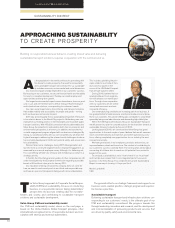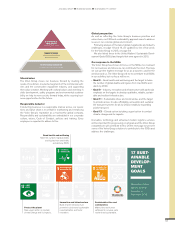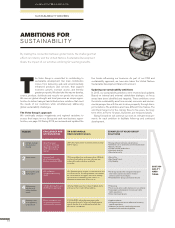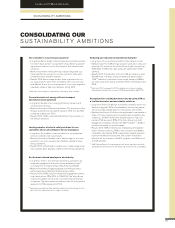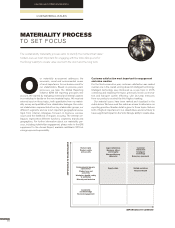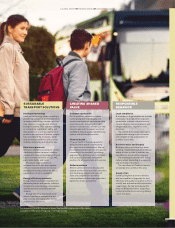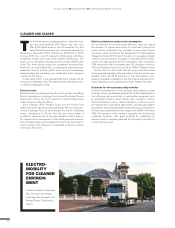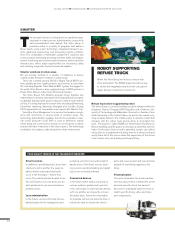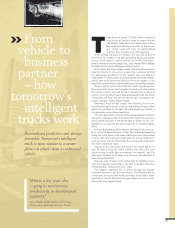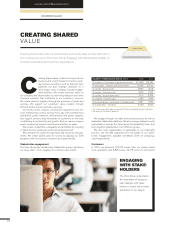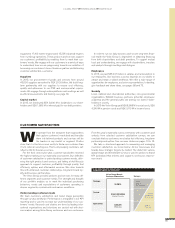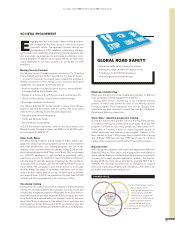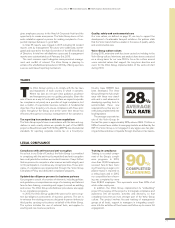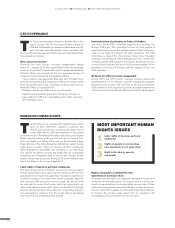Volvo 2015 Annual Report Download - page 64
Download and view the complete annual report
Please find page 64 of the 2015 Volvo annual report below. You can navigate through the pages in the report by either clicking on the pages listed below, or by using the keyword search tool below to find specific information within the annual report.
A GLOBAL GROUP BUSINESS MODEL SUSTAINABLE TRANSPORT SOLUTIONS
The transport industry is being driven by rapidly develop-
ing trends in smart services, administration, connectivity
and personalization (see below). The Volvo Group is
presently active in a variety of programs that address
these trends using smart technology, integrated transport sys-
tems, advanced engineering, and pioneering vehicle combina-
tions. The combination of telematics, advanced IT solutions and
communication technology providing real-time traffic information,
remote monitoring and communication between vehicles and the
infrastructure, offers major opportunities for increasing safety
and reducing congestion and environmental impacts.
Smarter solutions in urban areas
We are actively involved in a number of initiatives to deliver
smarter public transport solutions in urban areas.
There are currently around 250 Bus Rapid Transit (BRT) sys-
tems globally and we supply products and services to more than
30, including Bogota’s Trans-Milenio BRT system, the biggest in
the world. Volvo Buses is also supplying buses to BRT systems in
Brazil, Chile, Mexico, India, South Africa and Sweden.
The Volvo Buses’ City Mobility program brings together key
stakeholders to develop and implement integrated and innovative
sustainable transport pilot projects that are suited to each individ-
ual city. It is being deployed in several cities including Gothenburg,
Stockholm, Hamburg, Montréal, Shanghai and Curitiba. During
2015, agreements on cooperation were signed with Mexico City.
Volvo Bus Zone Management is a service that enables compli-
ance with restrictions in various kinds of sensitive areas. The
technology automatically regulates how the bus operates in spe-
cific zones along the route. GPS is used to determine exactly
where along the route the bus should run on electricity or diesel,
and also how fast it may drive in the various zones. The technology
contributes to a cleaner, safer and quieter urban environment.
FOUR SMART TRENDS IN THE TRANSPORT INDUSTRY:
Smart services
In addition to predicting faults, truck man-
ufacturers will, in another few years be
able to better understand why faults
occur in the first place – before they
occur. The vehicle will also be able to rec-
tify minor faults on its own and issue an
alert and book its own service before a
problem arises.
Less administration
In the future, service will involve far less
administration for the haulage firm and
workshop since the truck will be able to
handle most of this itself, such as book-
ing a service and downloading and updat-
ing its own on-board software.
Connected devices
In the future all the products around us,
such as watches, jackets and cycle hel-
mets, will be able to communicate directly
with one another as long as the connec-
tion adds value. Tomorrow’s wristwatch,
for example, will not just show the time, it
will also be able to monitor the driver’s
pulse and issue an alert and even activate
autopilot if something happens to the
driver.
Personalization
The more information the truck manufac-
turer has about whom is behind the wheel
and who owns the truck, the easier it
becomes to individually tailor the truck to
match specific driving styles and trans-
port assignments.
Refuse truck driver supported by robot
The Volvo Group is currently working on a joint initiative within the
Academic Partner Program (APP) together with Chalmers Uni-
versity of Technology and Mälardalen University in Sweden, Penn
State University in the United States, as well as the waste recy-
cling company Renova. The initiative aims to develop a robot that
interacts with the refuse truck and its driver to accomplish the
work. The project is called ROAR, for Robot-based Autonomous
Refuse handling, and the goal is to introduce a robot that, with the
help of instructions from a truck’s operating system, can collect
refuse bins in a neighbourhood, bring them to a refuse truck and
empty them. All of this occurs under the supervision of the refuse
truck’s driver, who can thereby avoid heavy lifting.
SMARTER
ROBOT SUPPORTING
REFUSE TRUCK
Within the Volvo Group we foresee a future with
more automation. The ROAR-project provides a way
to stretch the imagination and test new concepts to
shape transport solutions for tomorrow.
62


